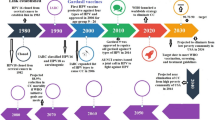Abstract
Human papillomaviruses (HPV), and human cytomegalovirus (HCMV) have been associated with cervical carcinogenesis. To our knowledge, there has been no report on the role of HCMV in the clinical behavior of cervical cancer. We recently reported that the presence of HPV DNA correlated with a higher incidence of lymph node metastasis, and we now report on whether or not HCMV DNA was present in those 433 cervical carcinomas; 113 cases (26.3%) were confirmed to contain HCMV DNA. HCMV+/HPV+ patients but not HCMV−/HPV+ patients had a significantly higher rate of metastasis to the lymph nodes, compared to HCMV−/HPV− cases (27/92, 29.3% compared to 8/70, 11.4%,P<0.025). Interestingly, the synergistic effects of HCMV and HPV only existed in cervical carcinomas with HPV type 16, and not in those with other HPV genotypes. Only in HPV16+ cases did the presence of HCMV in tumors enhance lymph node metastasis (17/48 compared to 30/152,P<0.05). The results underline the prognostic significance of HCMV in HPV16+ cervical cancer.
Similar content being viewed by others
References
Albrecht T, Boldogh I, Fons MP, Valyi-Nagy T (1993) Activation of proto-oncogenes and cell activation signals in the initiation and progression of human cytomegalovirus infection. In: Becker Y, Darai G, Huang E-S (eds) Molecular aspects of human cytomegalovirus diseases. Springer, Berlin Heidelberg New York, pp 384–411
Boldogh I, AbuBakar S, Albrecht T (1990) Activation of protooncogenes: an immediate early event in human cytomegalovirus infection. Science 247:561–564
Chen T-M, Chen C-A, Wu C-C, Huang S-C, Chang C-F, Hsieh C-Y (1994) The genotypes and prognostic significance of human papillomaviruses in cervical cancer. Int J Cancer 57:181–184
DiPaolo JA, Woodworth CD, Popescu NC, Notario V, Doniger J (1989) Induction of human cervical squamous cell carcinoma by sequential transfection with human papillomavirus 16 DNA and viral Harvey ras. Oncogene 4:395–399
Fujinaga Y, Shimada M, Okazawa K, Fukushima M, Kato I, Fujinaga K (1991) Simultaneous detection and typing of genital human papillomavirus DNA using the polymerase chain reaction. J Gen Virol 72:1039–1044
Hausen H zur (1991) Human papillomaviruses in the pathogenesis of anogenital cancer. Virology 184:318–319
Howley PM (1991) Role of the human papillomaviruses in human cancer. Cancer Res [Suppl] 51:5019S-5022S
Huang E-S, Kowalik TF (1993) The pathogenicity of human cytomegalovirus: an overview. In: Becker Y, Darai G, Huang E-S (eds) Molecular aspects of human cytomegalovirus diseases. Springer, Berlin Heidelberg New York, pp 1–45
Huang E-S, Boldogh I, Mar E-C (1983) Human cytomegaloviruses: evidence for possible association with human cancer. In: Philips LA (ed) Viruses associated with human cancer. Dekker, New York, pp 161–193
Hurlin KP, Smith PP, Perez-Reyer N, Blanton RA, McDougall JK (1991) Progression of human papillomavirus type 18 immortalized human keratinocytes to a malignant phenotype. Proc Natl Acad Sci USA 88:570–574
Jordan MC, Rousseau WE, Noble GR, Steward JA, Chin TD (1973) Association of cervical cytomegalovirus with venereal disease. N Engl J Med 288:932–934
Kurman RJ, Schiffman MH, Lancaster WD, Reid R, Jenson B, Temple GF, Lorincz AT (1988) Analysis of individual human papillomavirus types in cervical neoplasia: a possible role for type 18 in rapid progression. Am J Obstet Gynecol 159:293–296
Pecoraro G, Lee M, Morgan D, Defendi V (1991) Evolution of in vitro transformation and tumorigenesis of HPV 16 and HPV 18 immortalized primary cervical epithelial cells. Am J Pathol 138, 1–8.
Smiley ML, Mar E-C, Huang E-S (1988) Cytomegalovirus infection and viral-induced transformation of human endothelial cells. J Med Virol 25:213–226
Ting Y, Manos MM (1990) Detection and typing of genital human papillomaviruses. In: Innis MA, Gelfand DH, Sninsky JJ (eds) PCR protocols: a guide to methods and applications. Academic Press, San Diego, pp 356–367
Xu W, Sundqvist V-A, Brytting M, Linde A (1993) Diagnosis of cytomegalovirus infections using polymerase chain reaction, virus isolation and serology. Scand J Infect Dis 25:311–316
Author information
Authors and Affiliations
Rights and permissions
About this article
Cite this article
Chen, TM., Chang, CF., Chen, YH. et al. Coexistence of human cytomegalovirus and human papillomavirus type 16 correlates with lymph node metastasis in cervical cancer. J Cancer Res Clin Oncol 122, 629–632 (1996). https://doi.org/10.1007/BF01221196
Received:
Accepted:
Issue Date:
DOI: https://doi.org/10.1007/BF01221196




